PRODUCTION OF PET FOOD WITH 3D
PRINTING: MYTH OR POSSIBILITY?
Small-scale 3D printing of pet treats may soon be no longer just a dream.
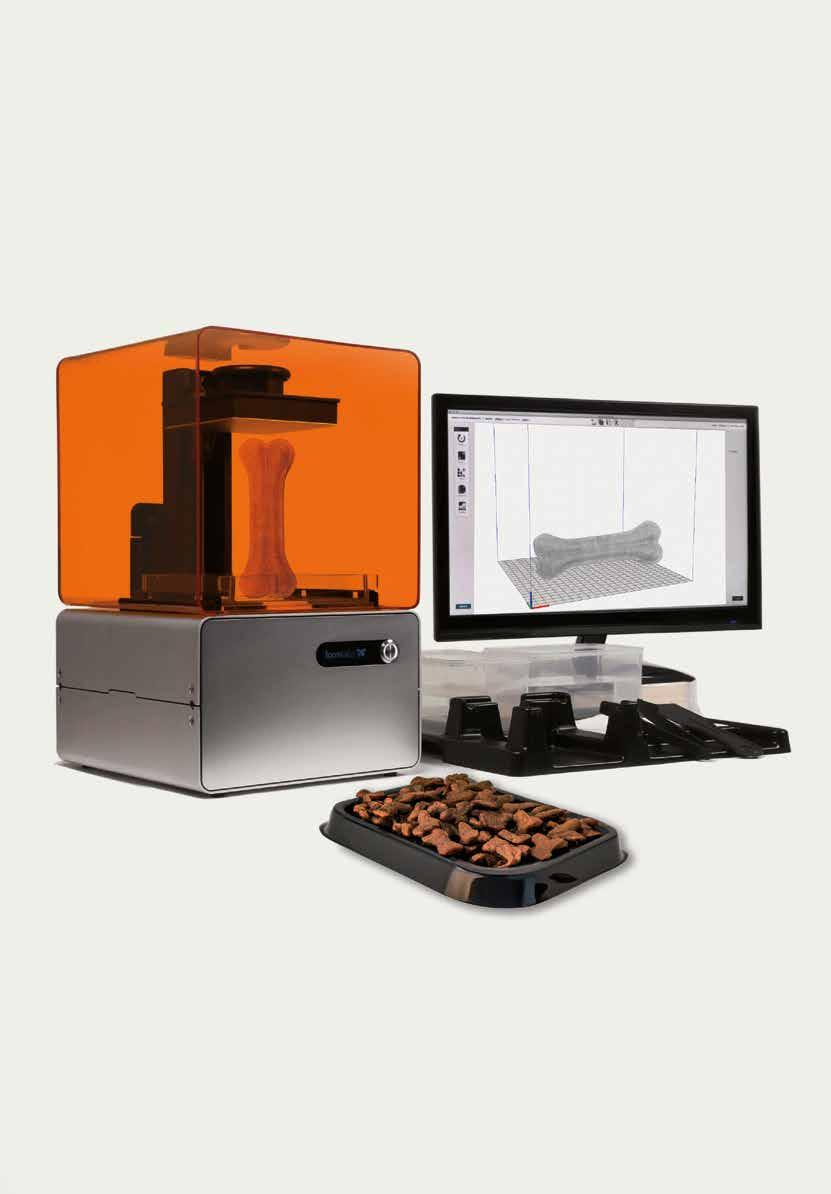
THE INTERVIEW
MARCELO BERALDO DA COSTA
BLOCKCHAIN, THE REVOLUTION IN DATA EXCHANGE AND TRANSPARENCY IN FOOD TRACEABILITY
FAMSUN: CYPZ SERIESVACUUM COATER
INTERNATIONAL MAGAZINE ABOUT THE PET FOOD INDUSTRY
Issue N° 14 Volume V - January 2023
MAGAZINE




2 — Symrise Pet Food is the global leader of high value solutions improving pets’ well-being and owners’ satisfaction. — Discover our brands supporting pet food manufacturers on three essential aspects of their products: Pet Nutrition Pet Food Palatability Pet Food Protection or visit our website https://petfood.symrise.com *Videka is a joint venture between Symrise & Kalsec.
INTERNATIONAL MAGAZINE ABOUT PET FOOD INDUSTRY
All Pet Food
Alvear 44, Chacabuco
Provincia Buenos Aires–Argentina Info@allpetfood.net
Managing Director
Pablo Porcel de Peralta pablo.porcel@allpetfood.net
M. +54 9 2364-537698
Sales manager
Iván Marquetti ivan.marquetti@allpetfood.net
M. +54 9 2352 501730
Director’s assistant
Victorina Manes victorina.manes@allpetfood.net
Editorial Team
Maria Candelaria Carbajo
Victorina Manes
Ludmila Barbi Trindade
Erika Stasieniuk
Armando Enriquez de la Fuente Blanquet
Fernando Raizer
Juan Manuel Peralta
Design & Layout Manager
Laureano Cane
Juliana Di Palma
Software development
Matías Basile
Matías Schettino
Our Community Web: www.allextruded.com
Linkedin. https://bit.ly/36SK5MT
Facebook https://bit.ly/3kGFJk5
Twitter: https://bit.ly/3ByDbdY
Youtube: https://bit.ly/3izL0Hn
8
How can technology improve supply chain challenges?
12 Blockchain, the revolution in data exchange and transparency in food traceability
3 MAGAZINE
© Copyright 2020 ALL PET FOOD All rights reserved. No part of this publication may be reproduced in any form or by any means without the prior permission of the copyright owner. More information can be found at www.pcm-group.net ISSN 1464-0058 Issue N° 14| Volume V| January 2023 IN THIS ISSUE
4 Editorial
Automation trends in pet food packaging 20 NIRS, the solution to food quality analysis 24 Successful control system modernization 26 Troubleshooting a Flushing Feeder 30 Production of pet food with 3D printing: myth or possibility? 32 Technology Showcase 34 STATEC BINDER GmbH: High-performance products for high-standard customers 36 Ferraz: from Brazil to the world 38 Grinding: A fundamental point in the manufacture of extruded dry food for cats and dogs
The Interview: Marcelo Beraldo Da Costa Latam Director at AFB International
What is the technology inside pet food? 50 Marketplace Industry suppliers
14 Automation in pet food: achievable or unrealistic? 18
40
44
EDITORIAL HAPPY NEW YEAR!
Even though 2023 is looming with the economic recession in most of the planet’s major economies, the pet food industry continues its sustained growth, and this new year won´t be an exception.
All Pet Food will continue in the new year with new projects and events in Latin America and the world with the celebration of All Pet Food Day, a face-to-face event at the Cosmos Hotel in Bogota, Colombia, and the first edition of CIPEU 2023 – European Pet Food Industry Congress, to be held in September 2023 in Zaragoza, Spain, in collaboration with Feria Zaragoza.
The arrival of winter in the northern hemisphere, and summer in the southern one, brings new challenges and innovations for our industry. You can see examples of this in the first edition of the year of All Pet Food Magazine, such as the possibility of the production of snacks with 3D printing. This futuristic technology can even use novel ingredients, such as proteins from insects and algae. Research suggests that 3D printing has potential for the creation of sustainable pet food and new product development.
On the other hand, Blockchain technology comes to light in this edition, which is having a strong impact on the pet food industry, especially in the agricultural supply chain and aims to improve the automation of companies, as well as precision, repeatability , increases productivity, facilitates scalability and reduces waste and human error.

Northwind and Schenck Process, two of our clients present topics of great importance for the different processes such as the modernization of the Control System in a factory and the solution of problems of a washing feeder.
In addition to other very interesting topics for the industry such as Statec Binder’s Flexible Packaging Technology, Famsun’s new vacuum coater and Ferraz’s worldwide solutions, we have an interview with Marcelo Beraldo da Costa, the new AFB International Director for LATAM, who tells us about the new challenges, growth, innovations and solutions the company will be working on during this year.
Undoubtedly, a start of the year that invites us all to daydream about new technologies and solutions for our Industry. We wouldn´t want to end without first thanking all our customers, sponsors and readers who accompany us during all these years, as well as our followers on social media and at the different Events & Congress All Pet Food organizes for the industry globally.
Happy 2023 to all!
4 MAGAZINE All Pet Food editorial team


The Future Awaits
Built on partnership and innovation, Wenger is providing more opportunities for client success.
For almost a century, Wenger has delivered extrusionbased innovations to our partners. We’ve worked alongside you to develop new processing solutions and better products, providing our industry-leading expertise and ongoing support every step of the way.
We don’t plan on stopping any time soon.
Wenger’s global food processing family is growing, and we look forward to the exciting opportunities that lie ahead. We will continue to deliver even more innovations and technologies to benefit companies that share our vision of tomorrow.

Wenger.com



www.schenckprocess.com americas@schenckprocess.com 816-891-9300 » Pneumatic Conveying – Extruder to dryer – Dryer to coating – Coating to storage/mixing silos – Silos to packaging » Feeding – Gravimetric feeding of palatants » Sifting – Pre-extrusion – particle classification System Solutions in Bulk Material Handling More Information
HOW CAN TECHNOLOGY IMPROVE SUPPLY CHAIN CHALLENGES?
 By All Pet Food
By All Pet Food
Considering both the drastic and rapid changes and the unforeseen events that have occurred in recent years, it is difficult to imagine a smooth supply chain without any inconvenience or interruption. Unfortunately, this exceeds the pet food industry: it is, in fact, an international problem that crosses any border and market.
In context
Two years ago, the chaos caused by the pandemic revealed the downside of common practices like just-in-time manufacturing and inventory control, inevitably causing many companies to revise their operating strategies. But, the truth is that, if we analyze objectively, most of these problems existed before March 2020. But what is the main cause? What are the recovery forecasts? What are the current stressors? And most importantly, what can we do to address these challenges?
To make things worse, in the pet food industry, countless headlines in recent times highlight the rise of pet ownership, the expansion of the sector, developments in production and packaging, and even remark that food exports are increasing, all aspects of a solid and growing sector… with a supply chain plagued with obstacles and difficulties. Among these articles, we find a few that speak to this B-side: complications with ingredient procurement, container and packaging sourcing, transportation management, and potential risks
8
to the availability of meat and poultry products due to livestock diseases, for instance.
It is due to several of these drawbacks that organizations are digitally transforming the way they manage their supply chains by implementing technologies such as Blockchain, artificial intelligence, machine learning, IoT, and augmented reality. The result will be a massive increase in automation as well as trust and transparency throughout the supply chain, with increased physical asset tracking capabilities and shared documentation globally.
Advanced manufacturing and automation are already changing supply chains and will continue to reshape the workforce and supply cost management.
What will happen, then, with pet food supply chains?
Once again, we can affirm that new technologies have the power to provide some answers and new paths to follow.
First, let’s see what the current challenges are: Transportation
The bottlenecks stifling transportation are not new: they have only been exacerbated during the pandemic. Logistics-related challenges include coping with ever-larger ships and other forms of transportation, which means unloading more merchandise in tight spaces; the need for more modern cranes to operate at higher speeds, traffic congestion, lack of parking for truckers, and more obstacles.
Raw material supply
Supplies of animal matter are scarce
A recent pet food consumption report by the US Institute for Pet Food Education and Research indicates that beef and animal fats are the 4th and 5th largest category of animal ingredients in pet food by volume. What’s happening is that, as fuel refiners add “renewable diesel” to their product mixes, they are using up stocks of the fats used to process biodiesel, including animal ones. The greater diversion of this raw material towards biofuels recently has pushed up the prices of all kinds of animal fats internationally.
On the other hand, to these increased costs, we must add possible outbreaks of viruses or diseases that can further reduce the availability of ingredients of this type.
As the last point, we cannot fail to highlight the warlike factor presented by the Ukraine war. Raw materials such as sunflower oil, white fish, cereals, and Russian fertilizers continue on the list of main affected in terms of availability, logistics, and distribution.
Packaging disadvantages
The problems that affect pet food manufacturers also affect manufacturers of packaging materials (and vice versa). Limited supplies of materials to create packaging or
containers such as glass, cardboard, and aluminum and the scarcity of cargo containers to move them, for example, are a plus that delays and hinder the development of a fluid and efficient chain. The lack of materials is closely related to the energy crisis that has been taking place year after year in China, a major producer and exporter of these materials such as aluminum packaging, whose process requires magnesium, an element that requires a lot of energy to work. This need drives the government to reduce the manufacture of this type of packaging, which directly implies its availability.
It is due to several of these drawbacks that organizations are digitally transforming the way they manage their supply chains by implementing technologies such as Blockchain, artificial intelligence, machine learning, IoT, and augmented reality. The result will be a massive increase in automation as well as trust and transparency throughout the supply chain, with increased physical asset tracking capabilities and shared documentation globally.
New technologies at the service of the supply chain
Digital printing
In response to the problems with these materials necessary for the creation of packaging, digital printing appears: not only does it offer a much faster response time, but several companies that are implementing it can obtain all the necessary materials in their local industry (or, at least, at a national level).
The B side of this packaging option is its limitation in terms of bag sizes that can be achieved today.
AI in control systems
The current technology allows connecting people to almost anywhere in a production facility. If we use technology for communication, production teams will become more collaborative and effective, and operational and maintenance support areas will be able to reach multiple facilities.
The companies at the forefront of technological innovation in the industry are already using high-performance graphics that highlight only the relevant information, as well as intelligent notifications based on the parameters of each machine.
Industry 4.0
Internet of Things (IoT) technology enables data conversion into actionable insights, Big Data analytics, and machine learning training to improve performance and adjust it at optimal times, as well as global access to data through cloud-based storage. Today’s solutions deliver data at microsecond intervals and overlay machine learning to make small adjustments to the process that optimize production results as they go. This technological advance implies computing power, technical connectivity, and data integration improvements.
9
For its part, data acquisition and integration with automated enterprise resource planning (ERP) and manufacturing execution systems (MES) improve efficiency and optimize processes.
Hyper-automation
Hyper-automation is a framework that combines various technologies, such as legacy platforms and emerging technologies. It is being widely adopted in service-oriented and repetitive supply chains, such as the generation of compliance documents and the exchange of information through software applications.
Digital twin in the supply chain
A digital twin in the digital supply chain (DSCT) digitally represents the physical supply chain. It emerges from all the crucial and relevant data in the supply chain (end to end) and becomes the basis of decision-making.
Edge Computing
It’s all about processing and analyzing data close to its collection point while matching IoT devices. This technology is especially needed during the demand for low-latency processing and real-time, automated decision-making.
Smart (more) warehouses
Organizations are pushing for “smarter” warehouses by leveraging emerging technologies like IoT and RFID (Radio Frequency Identification) for better data transmission and avoiding blind spots.

We definitely can transform operating models with technological proposals.

Given the vulnerabilities in supply chains exposed during the pandemic, the logical progression would be to leverage digitalization with smart technologies.
For this, companies must seek innovative technologies with the potential to disrupt and transform current operating supply chain models. Technological advancement will drive changes to the existing system for delivering products and services, and will revise the process of generating and sharing data across a more diverse set of functions.
Undoubtedly, the future of supply chains and global trade, in general, will be completely transformed with the development of an increasingly digitized environment.
10
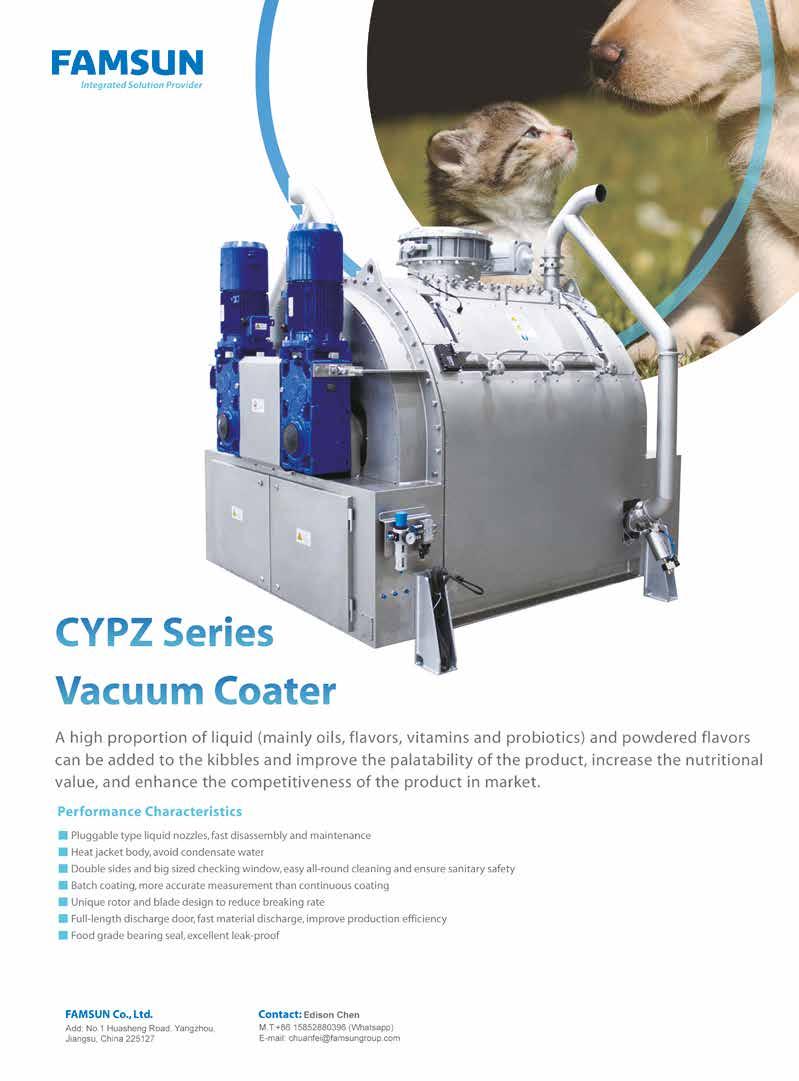
BLOCKCHAIN, THE REVOLUTION IN DATA EXCHANGE AND TRANSPARENCY IN FOOD TRACEABILITY
By All Pet Food
Technological innovation is breaking its path into all markets. Its various uses allow for adding value and transparency in the different sectors and business areas. And, if we talk about transparency, we must also name Blockchain, a technology impacting strongly in the pet food industry, especially in the agricultural supply chain.
Technology revolutionizing the market
Blockchain is being presented as the solution to track the food system from beginning to end.
Much is said these days about market disruption, and along with it, we can name tech innovation. However, when it comes to agricultural technology, few have managed to demonstrate its potential to improve safety, sustainability, and traceability, as Blockchain is proposing now.
Although the rise of this technology happened hand in hand with Bitcoin and other cryptocurrencies, it took a short time for companies to notice its potential for other uses and functions. Among them, we may remark on the possibilities and benefits it could bring to the pet and human food industries.
But what is Blockchain?
In simple words, Blockchain is a shared database that stores information in blocks with fixed storage capacities, linked by cryptography or code. New data forms new blocks, which are linked to the previous one in chronological order.

12
How does Blockchain impact the pet food industry?
The truth is that, to this day, we can name different reasons to adopt almost any technology, but if we talk specifically about Blockchain, we can surely number more than one! Indeed, we dare to say its great advantage is that data, once captured in the chain, is unalterable.
Currently, many pet food companies are focused on implementing Blockchain technology for agricultural tracking and final product delivery to know all information about the pet food production environment. Some examples are: field-level data mapping, crop data, traceability, sustainability, warehouse receipts, and order payments.
Blockchain benefits in food traceability
The traceability area is adapting and taking advantage of Blockchain benefits. As of today, we are seeing it being used to handle the volume and complexity of data involved, such as keeping track of supply chain data, origin field, ingredient expiration dates, food safety warranty, and carbon footprint measurements. Currently, it is estimated that 95% of Blockchain applications in development are focused on traceability.
The truth is that data ownership and business models based on related data are sensitive topics, surrounded by debates, at least until now. However, the interesting thing about this technology is that the information embodied in Blockchain is immovable and unchangeable. In this technology, as it is a decentralized system, there is no data “owner”, as we have conceived the term until now. Otherwise, the property corresponds to everyone and no one at the same time, allowing all people to access the information in the chains. Thus, we could say that everyone is the owner of their own data, which, in turn, is shared freely and transparently.
Therefore, we understand that another great Blockchain benefit is the ease it brings to do more efficient, less risky, and less expensive international business.
It should be noted that the benefit is mutual: while companies obtain as much knowledge as possible about the history of their raw materials, consumers themselves, who may one day have the possibility of accessing data from the entire chain, could gain in-depth knowledge of where the pet food and their ingredients come from.
Due to its ability to collect data chronologically in a chain, and with total transparency, the industry recognizes that Blockchain can be especially beneficial in terms of traceability, not only because of the possibility of knowing the history of all matters and procedures, but also because it offers quantitative models to efficient detection of toxins, dioxins, polychlorinated
biphenyls (PCBs), heavy metals, mycotoxins, Salmonella and other pathogenic bacteria. Sampling and automated testing, for example, can control final product contamination and adulteration, while creating a quantifiable record that can feed (and be nourished from) different companies.
This way, Blockchain technology application increases ingredient traceability from the raw material to the consumer’s plate. In a fragmented industry such as the food supply chain, this technology not only helps store data but keeps track of past quality, which also adds credibility to suppliers.
The traceability area is adapting and taking advantage of Blockchain benefits. As of today, we are seeing it being used to handle the volume and complexity of data involved, such as keeping track of supply chain data, origin field, ingredient expiration dates, food safety warranty, and carbon footprint measurements. Currently, it is estimated that 95% of Blockchain applications in development are focused on traceability.
Obstacles in Blockchain adoption
Blockchain is a relatively new technology for companies, and because it is in its initial phase, early adopters (those who are the first to implement it) will encounter some obstacles:

• Investment: interest in technology needs protection regarding investment return, which is nowadays difficult to affirm.
• Regulation: data protection regulations of each region or country may interfere with Blockchain use and expansion.
• Standardization: to this day, there is still no global standard for Blockchain use in food value chains.
• Quality assurance: Blockchain cannot guarantee product safety or quality, but it allows stakeholders to quickly identify problems and bad actors.
• Scalability: the community continues to face the challenges of growing at scale.
Blockchain, a possible path to food traceability digitization
As new pet food production technologies create more efficiency opportunities for the entire supply chain, factories could take advantage of accumulated data to make their processes smarter. What matters is that regulated and shared data benefits consumers, at the end of the day, with more competitive pricing strategies and stronger analytical projections that result in better animal health, sustainability, and welfare.
Blockchain in food traceability digitization is in its initial stage.
However, it hides a great potential for the food and agriculture sectors. Achieving end-to-end supply chain transparency will be a great goal and benefit for all supply chain members.
AUTOMATION IN PET FOOD: ACHIEVABLE OR UNREALISTIC?
By All Pet Food
The automation of the pet food production process seems to be increasingly attractive for companies. And it is that automation serves many purposes, and the more technology advances, the more benefits and challenges arise. As some companies adopt this technology, others begin to consider following the trend, and, simultaneously, we begin to recognize the most substantial challenges to its successful and lasting implementation.
The main goal? To reduce conflicts and challenges of the pet food production system.
Currently, there are several points in the pet food production process where errors often occur which, in most cases, are not identified until the final product is obtained. It is here, precisely, where automation shines the most. Improving accuracy and repeatability, increasing productivity, facilitating scalability, decreasing waste, reducing human error, and improving security are just some of its outstanding benefits.
Within this enumeration, it is fair to say that, probably, the most important benefit is product quality consistency, regardless of the shift, employee, or context. In addition to its benefits, and due to its technological nature, automation presents itself as a great solution, at a time when operation and distribution are affected by labor shortages.
On the other hand, we cannot forget that automation, as well as practically all trends, derives directly from the human food production industry. This, added to the growing pet humanization, means that automation in pet food is nothing more than a natural consequence of the fact that both industries are in-
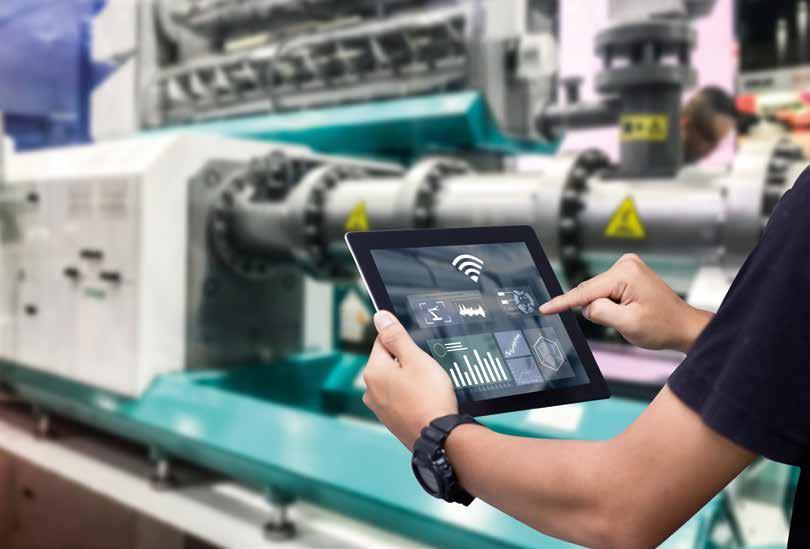
14


FOOD
. TM ©2022 AFB International AFB partners with pet food companies to provide palatant solutions that meet performance, attribute, and economic objectives. AFBInternational.com Contact your AFB account manager to discuss your unique palatant needs.
WE MAKE PET
TASTE GREAT
creasingly interconnected and merged into very similar processes and raw materials. So, as pet food has become more humanized, equipment transfer from human food processing to pet one has become more and more common. In fact, we’re even seeing companies that have historically been in human production now offering slightly modified equipment for the pet industry as well.
Challenges hindering automation implementation

So far, we have briefly discussed the benefits that automation can bring, but, logically, not everything is rosy for a technology still in the initial implementation phase.
But are there challenges? What are the ones that most companies have to face?
Finance and identifying what the company actually needs are just two of the major barriers to automation success.
While automation in pet food production is becoming more attractive at all process stages, there are still some challenges to its adaptation and implementation.
Financial investment
The first challenge to mention is obviously the initial investment required to install any automation technology in the company. If, in addition, we consider the difficulty that arises in contexts of economic instability and inflation as afflicted in several Latin American countries, we understand the fear that emerges when considering an investment of the size required to transfer the operations of a production factory to an automated system.
Of course, knowing how to make automation work within a particular company’s brand and understanding the benefits is key to being willing to make that investment.
“The most common challenge is understanding how to invest your money to get the most return. However, this challenge is lessening as the current job market has made it difficult for many companies to find workers. Automation can address labor shortages making the return on investment much faster.” Pete
Ensch, CEO of WEM Automation
Choosing which vendors to select to implement the right automation for successful operation is a challenge in itself.
For this, it is essential to have a certain degree of knowledge about the appropriate instrumentation to adapt to the environment and the specific measures required of the particular company.
This specific challenge extends to pet food in all facets, and different areas have different needs that they may or may not know how to satisfy with automation.
Stores and consumers
Pet food retail businesses are largely fragmented. Some have already been encouraged to experiment with (or are familiar with) automation to some degree. They are ready to use it and, above all, willing to continue to deepen its implementation. However, for their part, a large number of consumers have never heard of terms such as automation or artificial intelligence, so they are very skeptical or unwilling to change the current system which, in one way or another, works for them. This latter group will need much more time and information about the benefits automation and Internet of Things (IoT) systems with embedded AI and machine learning bring to all participants in the chain.
The future of automation in pet food production
Everything indicates that pet food is heading towards better quality, safety, and humanization, hand in hand with automation. This technology, according to experts, will continue to become increasingly intelligent for the benefit of food production.
Undoubtedly, technology and automation are here to stay.
The first challenge to mention is obviously the initial investment required to install any automation technology in the company. If, in addition, we consider the difficulty that arises in contexts of economic instability and inflation as afflicted in several Latin American countries, we understand the fear that emerges when considering an investment of the size required to transfer the operations of a production factory to an automated system.
Knowing what the company needs and the best way to achieve it

AUTOMATION TRENDS IN PET FOOD PACKAGING
By All Pet Food
By now, we all know what automation can do for pet food packaging. Being more efficient and scaling our production are just some of the benefits we are already experiencing, whatever the level of automation a company has achieved. However, the packaging sector is the one perceiving the major opportunities and benefits of converting manual processes into mechanized ones.
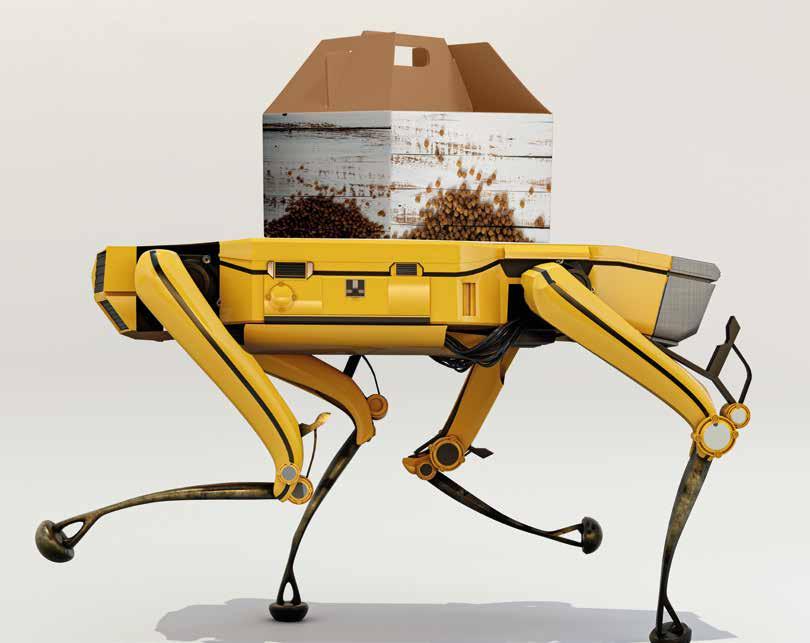
The man’s best friend: a market full of possibilities
In this era of pet food driven by quality suitable for a humanized pet, the options on the market have never looked so aesthetic and never had such a promising future ahead of them.
To be part of that bright future, packaging production companies are beginning to find alternatives to modernize their products and processes and adopt more sustainable and innovative approaches. Automation is undoubtedly the Queen of all technologies in test and deployment.
Packaging is also in demand
Recent growth in changing and challenging demand for different packaging styles demonstrates that there is room for both rigid and flexible versions. Factors from increased ownership to pet humanization are spurring further diversification in products and packaging.
“General demand in pet food is rising at quite a high rate, but this is quite generally known. What is more interesting to us is the increased diversity.” Milou Jansen, Lan Handling Technologies
Non-stop growth: automation in foodpackaging
Automation in the food packaging process involves robotics for food material handling in the packaging process. Currently, most of the facilities of this type use complex machines throughout the assembly line, compared to a few years ago, when the man was the one in charge of these tasks.
Application in the pet food industry
Today, there are robotic solutions for every task that makes up the packaging line, from simple pick and place to complex operations such as sealing or bag making.
Benefits of automation in food packaging
18
Security
Automated industrial robots increase workspace protection and safety, thus preventing worker injuries. In addition to reducing risk and proper machine maintenance, we can avoid system errors and breakdowns that can cause not only unforeseen expenses but also stop the production chain.
Contamination
The packaging stage presents a significant risk of biological, chemical, and physical contamination of food products (by foreign objects in the packaging materials, cleaning compounds, or dirty or broken packaging materials, for example). Using hygienic packaging methods that minimize human contact and other contamination sources is part of the automation benefits.
Scalability
The use of robotics in the food industry can increase production line productivity considerably, being able to process large volumes at an amazing speed and, at the same time, minimize the need for labor.

Flexibility
Robot performance and production can be adjusted according to each product requirement.
Reduced costs
By comparison, in the long run, manual canning is much more costly than automated canning, which requires less labor and little to no regular maintenance to avoid more costly breakages.
Result consistency
Since the packaging is done robotically, human error in operations, weighing, and precision is avoided.
Full traceability
Automated food packaging provides end-to-end traceability of the entire production line, providing accurate records of the facilities and processes a food product has gone through.
Sustainability
Automation can also be a step towards greater sustainability. Yes, machines require energy and raw materials, but by avoiding human error, waste is avoided in large quantities.
Automation trends in food packaging
The demand for robotics in the food packaging sector is increasing dramatically, mainly because more and more manufacturers are realizing the convenience and efficiency that these machines provide, so they are adopting them to meet the growing demand. Let’s know the most used variants currently:
Pick and place
Processed foods are often uniform in size and shape, making them easy to handle with a robotic gripper. Pick and place robots lift food products from one place and set them in another, even from a moving assembly line. With the simple action of picking and placing, they can identify, align and place the product simultaneously. The non-robotic alternative would be
to use fixtures, which are inflexible to product changes and can take up a lot of space.
Raw food packaging
This process involves taking raw or processed food products and wrapping them, such as raw vegetables, fruits, seeds, grains, etc. This primary packaging technology specializes in these items generally using paper or polyethylene material that does not chemically react with food and is cost-effective.
Depanning
Baked or frozen products are mass-produced, and robots are needed to leave them ready for primary packaging. This process typically involves scooping up an entire tray of baked goods with a specialized demolding tool.
Denesting
This process is often carried out with demolding: the demolding robot takes an object stacked in “the nest” and places it where it belongs. Robots that do this do not deal directly with food but rather sort packaged items for delivery to the packing station to reduce downtime.
Boxing
Secondary packaging involves taking individually packaged products and grouping them into boxes or containers already sealed. These robots, known as boxing machines or case packers, can be used in a variety of secondary packaging applications, including delicate food handling. In addition, they are also usually in charge of assembling the boxes from cardboard sheets.
Palletizing
Palletizing systems are the last step in the food production and packaging line. It involves stacking boxes one on top of the other and preparing them for distribution and shipping. This is almost always a tertiary packaging method accomplished by collaborative robots.
The future of packaging automation is positive
Food packaging has three main purposes: preserving products, providing information, and attracting consumers. Implementing a smart food packaging solution ensures that products are packaged in the most hygienic, informative, and attractive way possible.
The packaging process is often your last checkpoint before your product leaves your production facility, so getting it right is essential, but not just for food safety reasons. Today, it is an instance of the production process that, if done correctly and robotically, can bring great benefits (instead of problems) to the company.
Recent growth in changing and challenging demand for different packaging styles demonstrates that there is room for both rigid and flexible versions. Factors from increased ownership to pet humanization are spurring further diversification in products and packaging.
NIRS, THE SOLUTION TO FOOD QUALITY ANALYSIS
By All Pet Food
In recent years, the main wet chemistry analysis method used to determine nutrient levels in food samples has been NIRS analysis. So let’s learn a little more about this technology.
The NIRS technique, a possible path toward consistency
The NIR technique measures the response of NIR light in a sample of the material and uses this information to determine the composition or other qualities. Thus, it’s able to estimate the levels of nutrients in food products. Through mathematical models dedicated to the matrix to be measured, NIR devices are capable of delivering a concentration prediction of, as in this case, raw materials and finished products from the food industry.
During the calibration process, prediction models are developed that characterize the relationship between the NIR spectra of a particular material and conditions such as moisture, oil, protein, and fiber, among others.
This technology, near-infrared (NIR) spectroscopy, is a precise, non-destructive approach to sample analysis. Traditionally, it was carried out by scientists in the laboratory, but today we find portable devices on the market that bring this technique closer to different application spaces that, once a prediction model has been validated, can be used to obtain results from new material samples in seconds, saving time and money in laboratory analysis.
Advantages of NIR spectroscopy Affordable cost
Since there are no consumables to buy once you have the device, there are also no costs associated with each measurement. You may only have to pay the annual subscription to the device system.

20
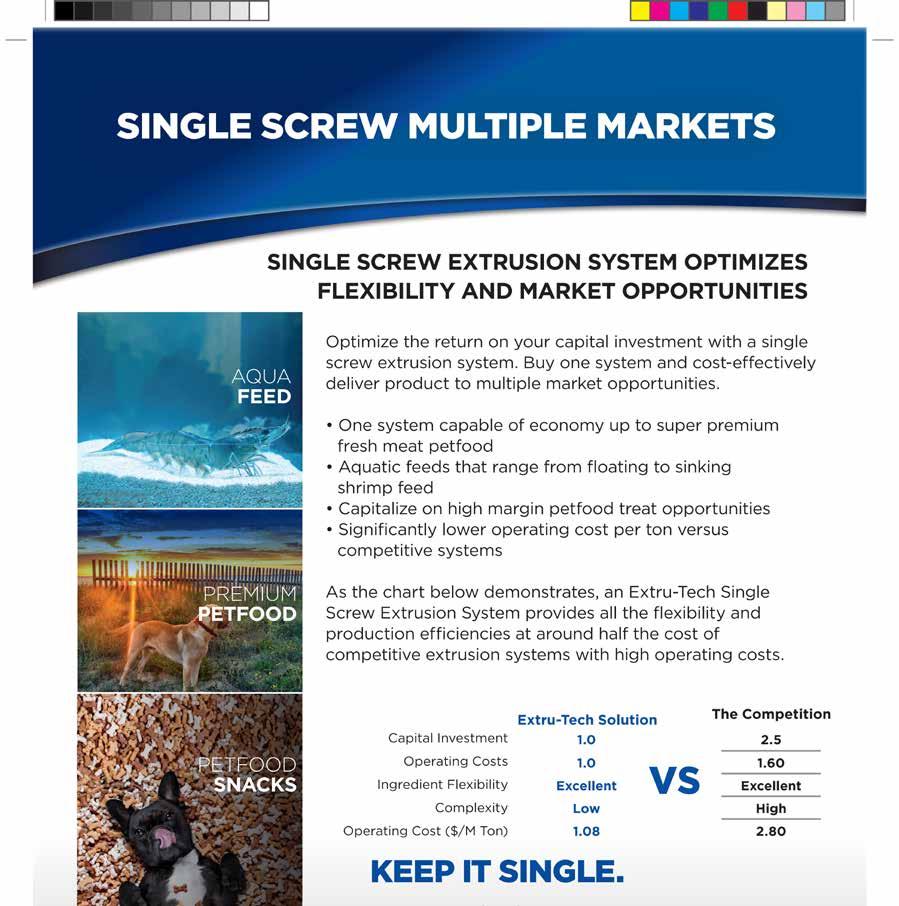

Fast results
This system has considerably reduced the time required for analysis. It is no longer necessary to wait for physical or chemical properties to change to obtain a result. We can know a material’s composition at any time.
Versatile and simple
With the possibility of measuring multiple parameters, NIR technology becomes very versatile, being able to offer the most varied information with just one measurement. In addition, the analysis and interpretation of the results can be done easily and with minimal training. With careful instrument design, measurements can be made by non-experts in spectroscopy. NIR analysis and the availability of comprehensive calibrations are particularly useful in helping producers manage the wide variety of ingredients typically used in pet food production.
Validated technique
NIR spectroscopy has been validated and has long been used as a standard material analysis technique and as a decision-making tool in various industries.
No need for chemicals
The analysis can be performed without any reagent. There is no need to worry about the risks of hazardous materials when taking a measurement.
No sample preparation
In most cases, analysis with NIR technology is non-destructive. On the contrary, measurements are made without altering the matter or product.
Product quality guaranteed
Among the myriad uses of NIR analysis in the pet food plant, one example is fat and moisture control to obtain the correct bulk density and physical stability of final products, which is especially important to ensure that products remain intact when the bag is opened, but still have the proper texture and palatability. For its part, humidity levels are also critical to storage considerations.
NIRS in the pet food industry
Near-infrared spectroscopy is used in the pet food industry for the rapid evaluation of various macronutrients and gross energy content. It is a fast and accurate method of predicting energy content in commercial extruded dog foods, and it’s useful and reliable for the pet food industry when a sufficiently comprehensive calibration set is available.
Feed producers often make several products with different recipes for a variety of animal species, and while having a global calibration simplifies the management and maintenance of that calibration, more specific techniques are often required to account for additional variations between products.
On the other hand, the applications and the spectra can also change due to sampling differences, instrument aging, different presentations, and years of cultivation. To adapt to the new conditions, the calibrations must be modified, and that procedure should ideally be simple and effective.
This technology, near-infrared (NIR) spectroscopy, is a precise, non-destructive approach to sample analysis. Traditionally, it was carried out by scientists in the laboratory, but today we find portable devices on the market that bring this technique closer to different application spaces that, once a prediction model has been validated, can be used to obtain results from new material samples in seconds, saving time and money in laboratory analysis.
An example of a portable spectrometer: Neo Spectra by Si-Ware
Recently, at Cipal 2022, the event we organized for the meeting and exchange of knowledge of the pet food industry, we learned about the Neo Spectra portable spectrometer, a mobile device that offers accurate and reliable results from anywhere. This, like many other devices on the market, allows easy and accurate measurement of a wide variety of parameters in materials, both homogeneous and heterogeneous. But, in addition, the Neo Spectra proposal allows access, through mobile applications, to prediction models created by experts worldwide uploaded in the same cloud. Some of its features are:
• Comprehensive coverage
• Collect samples from one to 10 mm in diameter with a single scan
• Ergonomic and one-hand use
• High-memory capacity
Towards the real value of NIR technology
Near-infrared spectroscopy is the most useful and reliable technology when a large enough calibration set is available.
While the use of NIR has long been a standard part of operations, new versatile portable devices are now allowing the value of this technology to be further exploited, making it available to everyone, from anywhere, instantly, quickly, and accurately.


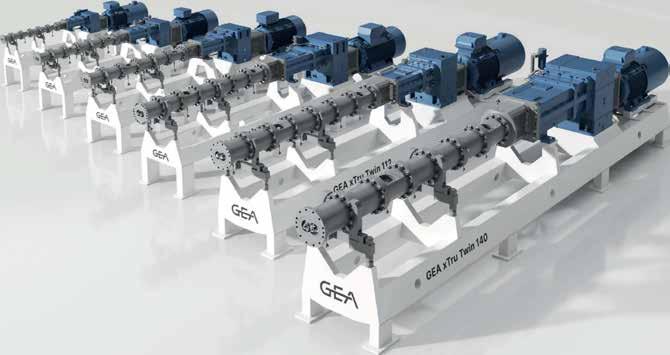
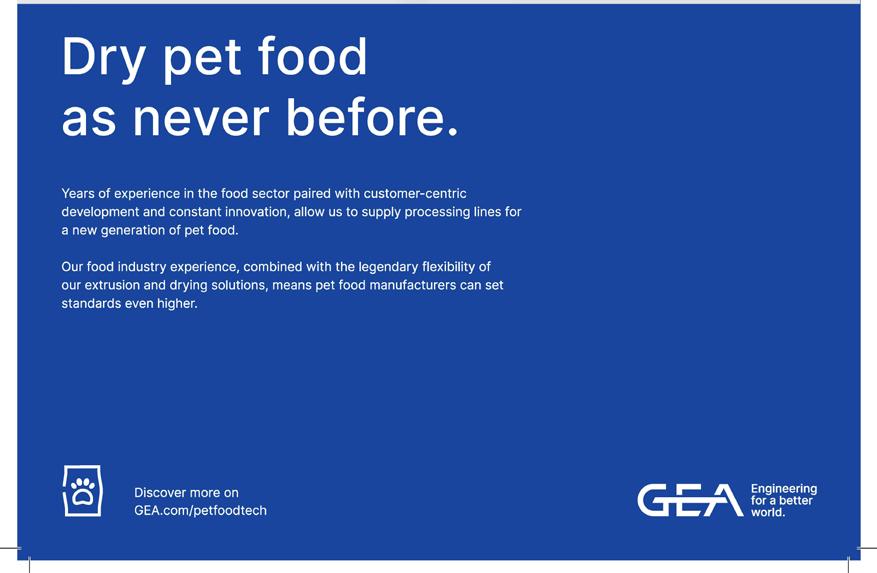 Kibbles
Pillows
Dental sticks
Kibbles
Pillows
Dental sticks
SUCCESSFUL CONTROL SYSTEM MODERNIZATION
By Blake Bennett - NorthWind
Manufacturers produce the products that our communities need. In today’s market of doing more with less, manufactures are often required to extend process system lifecycles longer and longer to avoid the time and expense of a greenfield project to replace the systems. What remains is an aging infrastructure that was built at a time when industrial automation was in its infancy. Weighed against new systems, these existing processes often have the same underlying mechanical technology but are generations behind in terms of controls and automation technology.
The most obvious illustration of this is systems that have obsolete electrical components and legacy software that is no longer actively supported by original manufactures. As we move into Industry 4.0, the old standard of each individual machine having an isolated “island” of automation is being replaced by more integrated automation systems that communicate to each machine, sharing and creating significantly more data than even 15 years ago. With this added data is the desire to connect the plant floor data to business systems. More and more facilities want production orders to come down from ERP systems to process controls, producing real-time consumption data that is utilized to reduce inventory. To stay competitive, many facilities have made the business decision to modernize their legacy machine and controls systems. Typically, this can be done at a fraction of the cost and time of a greenfield project.
Modernizing a control system
A control system upgrade can bridge all these gaps by integrating mechanically sound process systems with a modern automation system. At a minimum these projects consist of substantial replacement of obsolete components, sometimes even retaining the original PLC logic. These projects can also be expanded to include high level integration of different machines, adding new machines to an existing system, ERP integration, and ground-up re-writes of logic and operator screens.
Modernization projects are known to be complex, especially because engineers are required to work inside an existing framework as opposed to building a system from the ground up. There may be missing documentation or drawings. Additionally, some field modifications may not be included in the drawings. Minimizing production downtime is a significant concern, so the implementation window to get the system back in production is often small.
A successful modernization project considers these factors and others during the initial phases of the control system upgrade. Key to any project is developing a deep understanding of the existing system. This is paramount to implementing the upgrade without breaking what is currently in place.
Best practices
As a Senior Project Manager at NorthWind, I have implemented many modernization projects throughout my career. In this time, I have found a few tried and true practices that lead to a successful control system upgrade.
Customer/Project Management Planning
When modernizing any system, a collaboration between customer and Project Management is a must. Through this collaborative approach, a forward-looking plan is made to include

24
functionality, risk avoidance, down time reduction, migration solutions, project phasing, etc. to ensure the project scope is clearly outlined and understood.
Design Trip
There is a misconception that modernization will “break” the current system and lead to significant downtime. Conducting an initial design trip is instrumental for designing a project that takes into consideration the existing system and its functionality and designing a system that will meet the customers scope and needs.
Before any modernization takes place a review of pre-existing equipment, electrical, design and functionality is conducted. Any existing drawings and documentation are also thoroughly reviewed. In the event there are no drawings of the existing system, a new set will be created.

Safety Considerations

There are misconceptions involving safety considerations: Many people think that safety guidelines are grandfathered in by the date of the original mechanical equipment installation. However, on any substantial electrical modernization project, safety circuits and functionality need to be reevaluated.
Electrical Installation

One of the biggest concerns with control system modernization is the amount of time it will take for installation and requalification. Working with an industrial electrician with the expertise to understand how to work within schedule constraints and provide creative, custom solutions to meet outage windows is critical. Installation can be done in phases, during production downtimes, or any other number of solutions to keep downtime at a minimum.
Benefits of modernization
Updating hardware and software with better automation control systems can improve plant performance, increase productivity, improve communication between the process information and business systems, provide useful production data, provide alerts to improve response times, increase plant system security and perform system diagnostics.
With NorthWind you can achieve an effective modernization project that manages safety, health and environmental risks, get documentation for field devices in the system, and be assured of a more efficient, consistent and optimized operation, with the support of the system for years to come. Contact us today to talk about your system.
Providing the best Solutions for the Extruded Pet Food and Aqua Feed Industry
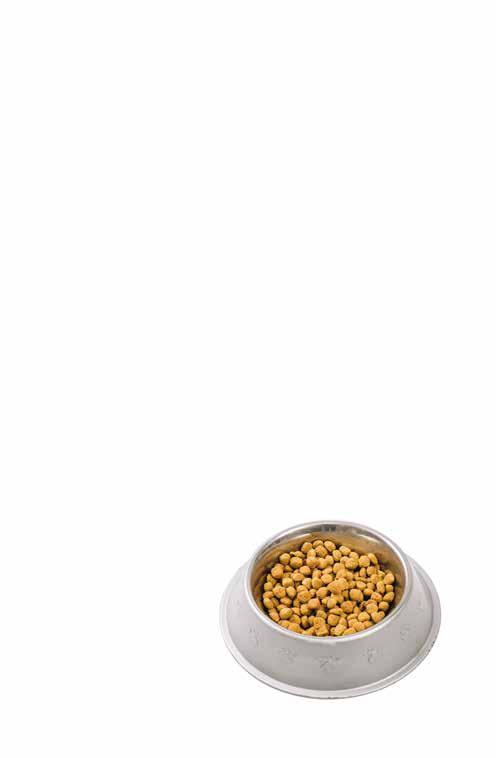
Projects: Focused mainly on companies manufacturing Extruded Pet Food and Aqua Feed, we develop Projects for complete or partial plants.
Solutions: We o er consulting work and provide Solutions to improve the E ciency and Quality of your Manufacturing Processes.


Representations: We only work with Associated Companies that can o er the Highest Quality of products and Services for our Customers.



francisco.pantoni@cliviosolutions.com +54-9-2352 54-0040 www.cliviosolutions.com
TROUBLESHOOTING A FLUSHING FEEDER
By SCHENCK PROCESS
“A variety of issues can contribute to material flushing”. From time to time, we hear from customers that material is flushing out of their feeders. Several things can contribute to or cause this. In this article, we will look at some of the more common issues associated with material flushing.
Low Angle of Repose
To start our investigation, we look at the material itself. Is it aeratable and, once aerated, does it fluidize like a liquid?
We can evaluate this by measuring the material’s angle of repose. Picture a pile of material sitting on a flat surface. The angle of repose is the angle between the flat surface and one side of the pile. Higher angles of repose happen when a material is cohesive and sticks to itself. Lower angles of repose mean the material is more free-flowing and could potentially be floodable.
Low-angle-of-repose materials are more prone to flushing out of a feeder than those with higher angles of repose.
Refill Set Points
The next place to look? Refill setpoints.
When the feeder calls for a refill, the incoming material aerates the material inside of the feeder. This can fluidize this material and flush it out of the feeder. When that happens, the entire line must be paused so the feeder can be properly refilled again.

The solution? Raise the set point until there is a nice heel or head of material over the feed screw. This will protect the rest of the material inside the feeder from the charge coming in. Because it is protected, the material inside of the feeder doesn’t fluidize.

In other words, you can prevent flushing of a low angle-of-repose, floodable material with more frequent, smaller refills.
Material Voids
We have looked at issues affecting low-angle-of-repose materials. However, even high-angle-of-repose materials sometimes flood out of a feeder. Two scenarios contribute to this:
• Ratholing
• Material bridges
Ratholing occurs when material forms a small void as it is being fed out. The material around this void can collapse in on itself and cause a flushing issue.
26
Insert Figure 1 in this section. Caption, Ratholing example



There is also the material bridge scenario. Like a rathole, a material bridge involves a small void. In this case, the void occurs in the shape of a small bridge over the feed screw. When this bridge collapses, the material can flush out of the feeder.
In either of these scenarios, a feeder with internal agitation may be needed to keep material from ratholing or bridging.
Is the material only flushing with the first refill? Filling a feeder with a floodable material for the first time can cause the material to flood out of the feeder. Three ways to prevent flooding in this situation are:

• Incorporating a center rod inside the feed screw to take up the void in the feed screw spiral or helix.
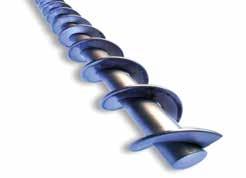

• Using a side discharge, which gives the material a wall or end cap to overcome before it is fed out.
Using a discharge plunger to stop the discharge of the feeder during the initial refill, then opening the discharge of the feeder the rest of the time. This is ideal for extremely floodable materials.
The next place to look is with the refill system itself: gravity, pneumatic, or vacuum.
Gravity System
In a typical gravity system of a bin with a refill valve at the bottom, a long drop to the feeder can cause the material inside the feeder to aerate and flush out. There are two ways to address this:
• Move the refill valve (butterfly valve or slide-gate valve) closer to the feeder so the material does not have as far to fall. This is the best option, but may not always be possible.
• Install a baffle inside the feeder’s extension hopper. The baffle can be a piece of angle iron pointed up toward the inlet of the feeder’s extension hopper. Or it can be a conical piece of material supported inside the feeder. These will baffle the impact of the material coming into the feeder. However, installing baffles can be tricky—material may hang up on them, and the hopper could eventually become blocked.
Clogged Filtration System
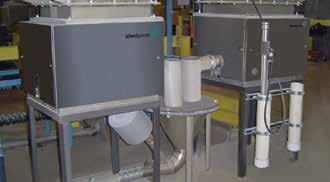
rod
Another place we need to look at is the filtration system of the feeder. If the feeder has a blinded-up dust sock, the air inside the feeder cannot move out as new material comes in. Air will always take the path of least resistance, so if one exit is plugged (dust sock), the air will find its way out through the discharge point of the feeder—and it will bring the material with it.
Downstream Effects
Finally, what is downstream of the feeder? Are we feeding into a pressurized or vacuum-type system below the feeder? The vacuum may be strong enough to pull the material out of the feeder before the feeder has a chance to weigh it. If this is the case, investigate isolating the feeder from the downstream vacuum with a vented rotary airlock or a smaller screw conveyor.
Reach Out for Help
Hopefully, these scenarios have given you some ideas of what to look at if you experience a flushing or flooding feeder. Feel free to give an applications engineer a call to help troubleshoot your system or, better yet, have a technician come out. This small investment can prevent significant losses of revenue from downtime and product waste.
Figure 2 in this section. Caption, Internal feeder agitation
feeder will allow the material to de-aerate before it is introduced
Figure 3 in this section. Caption: Refill bin above a feeder]
Figure 4 in this section. Caption: Helix with center

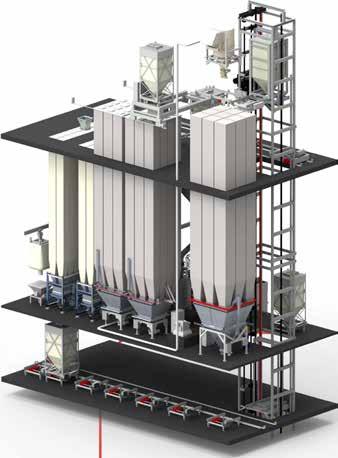
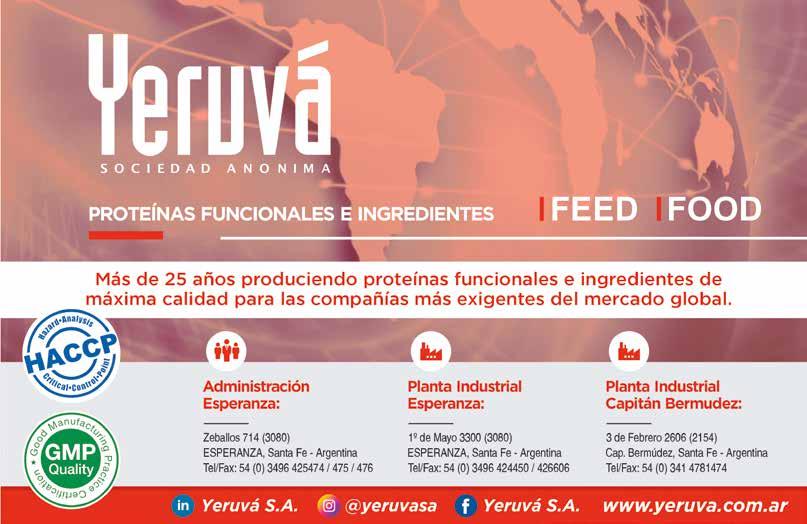
KSE Together we design your optimal pet food plan: • Dosing & weighing equipment • Process automation • Projects & consultancy • 24/7 service ksegroup.com
PRODUCTION OF PET FOOD WITH 3D PRINTING: MYTH OR POSSIBILITY?
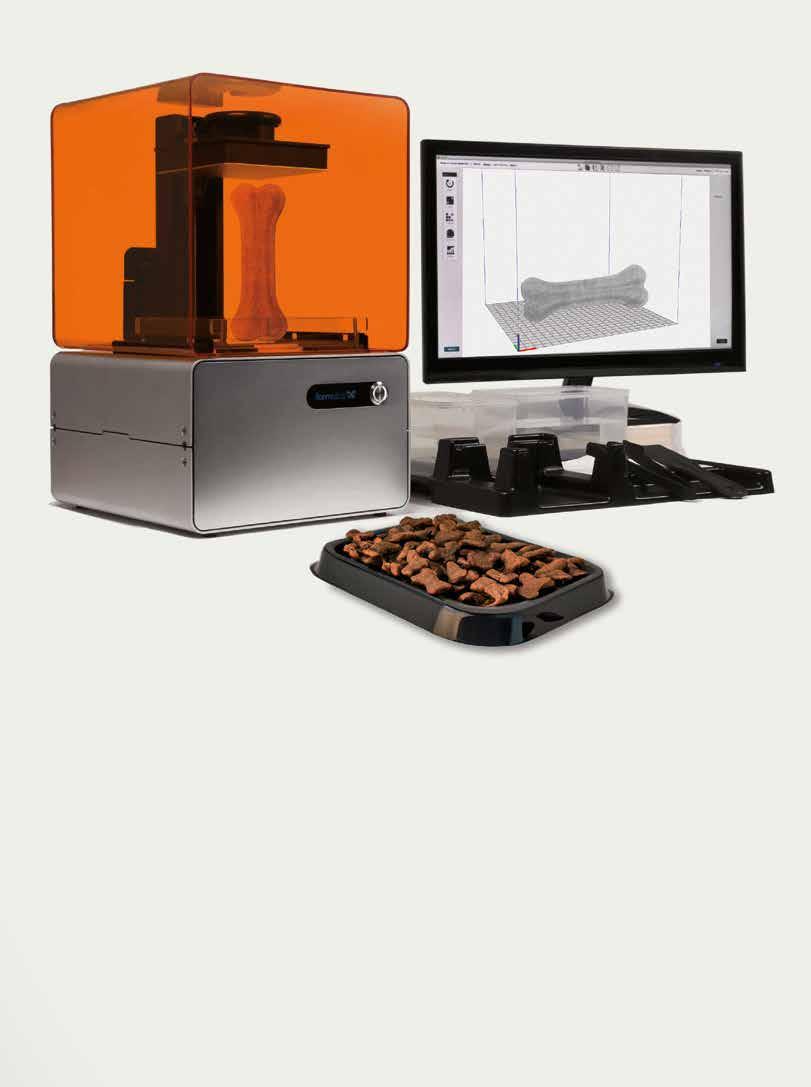 By All Pet Food
By All Pet Food
Small-scale 3D printing of pet treats may soon be no longer just a dream. What today seems like a rather futuristic snack, it can even be made up of innovative ingredients, such as insect proteins and algae. Research to date suggests that 3D printing has the potential for the creation of sustainable pet food and new product development.
Let’s get to know a little more about this technology that, it seems, is coming to settle, little by little, in the food market.
Potential of pet snacks created with 3D printing
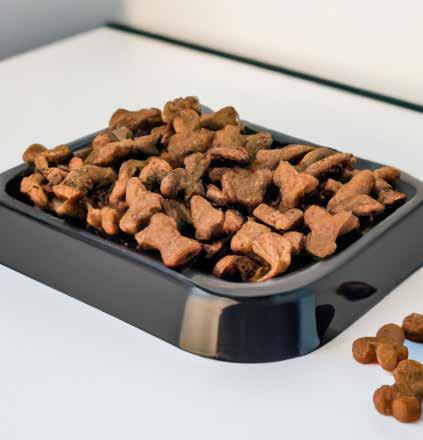
3D printers often serve as rapid prototyping and production devices. And, with the correct raw materials, some of those print creations can be consumed. As of today, most of these 3D-printed consumables are intended for humans, but the first experiments for animal food have already taken place since the technologies and ingredients for the production of pet food and meeting its requirements.
Surely, a custom 3D-printed dog biscuit could find a place on the shelves. Beyond production, it is estimated that 3D printing could also be used at home. In this way, the possibility of even a new market opens up: the same food company can be the one to offer an optimized 3D printing device for home production and then the materials needed as well. Another alternative that can be explored is that large and established companies can use 3D printing to optimize the development process of new products or even expand their range of services, offering personalized snacks with direct delivery to homes, for instance.
3D printing features
Also known as solid free-form manufacturing or additive manufacturing, 3D printing has a wide range of applications in different areas, such as biotechnology and design science, mechanical and biomedical engineering, aeronautical science, the pharmaceutical industry, and of course, the food industry.
Impression materials
Food materials used for extrusion-based 3D printing can be broadly categorized into natively printable materials, such as chocolate and cheese, which have excellent printing properties and extrude smoothly during printing. Second, non-printable traditional food materials, such as vegetables, meat, eggs, fish, and fruits, are non-printable by nature and require pre-processing.
Related research
Various studies have focused on analyzing the properties of different food inks and 3D-printed constructions based on animal proteins such as beef, poultry, fish, eggs, shellfish, milk, cheese, and dairy ingredients. Some studies examine the development of special diets based on animal proteins and the possibility of 3D-printed products based on cultured meat. Currently, studies have already been carried out with raw materials such as:
• Beef
• Fish
• Milk and dairy products
• Egg
• Cheese
Study conclusions
Research and studies carried out so far indicate that 3D food printing offers numerous possibilities for the development of customized structures and products based on animal proteins including, among others, extraordinary flexibility in geometries, textures and flavors, and personalized nutrition. On the other hand, this technology requires the reduction of the size of the meat particles and the dilution of the meaty and salty taste
and, in general, this is expected to reduce the value of premium meat products. Precisely for this reason, it is considered a great option for the use of harder and lower-value cuts and trimmings.
The three-dimensional printing of consumables, until recently, was a utopia
Products made with 3D printing hold great potential for the pet food sector, even becoming an important marketing tool to attract new potential consumers, especially young people.
Among the various forms, 3D printing is, by far, the most impressive emerging technology available to the food industry for preparing complexly shaped, personalized foods. In addition, it provides extraordinary flexibility in geometries, textures, and flavors, and is already attracting the attention of most companies in the sector.
Surely, a custom 3D-printed dog biscuit could find a place on the shelves. Beyond production, it is estimated that 3D printing could also be used at home. In this way, the possibility of even a new market opens up: the same food company can be the one to offer an optimized 3D printing device for home production and then the materials needed as well. Another alternative that can be explored is that large and established companies can use 3D printing to optimize the development process of new products or even expand their range of services, offering personalized snacks with direct delivery to homes, for instance.
However, although the future looks very promising, the truth is that pet food production with 3D printing is still in an experimental stage and, of course, will require further research and significant improvements before becoming a commercial reality.
31
TECHNOLOGY SHOWCASE
In this issue of All Pet Food Magazine, we highlight the latest innovations that can optimize your pet food operations. We take a look at innovations from different leading companies in the Pet Food market.
DULCOAPETENTE FLAVORS & SWEETENERS
Flavors & Sweeteners
Combination of natural and high-intensity sweeteners, in accordance with EU regulation 1831/2003
Dulcoapetente has a strong pleasant sweet taste and free from the typical aftertaste of high-intensity sweeteners. It reduces the rejections caused by bitter taste of drugs and poor palatable raw materials. Their use allows masking unpleasant tastes, improves palatability and increases feed intake
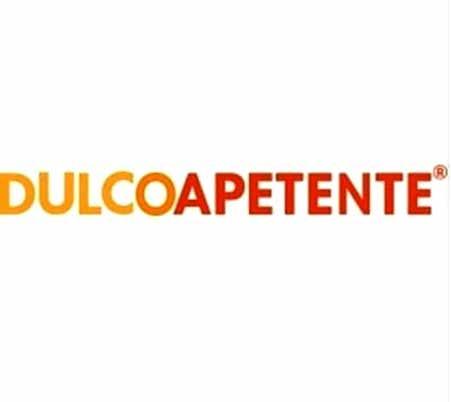
PRESENTATION:
Polvo: Saco de aluminio 25 Kg
Líquido: Bidones de 25 Kg
https://norel.net/en/products/flavors-sweeteners/ dulcoapetentedulcoapetente
PLASMA IN DRY PET FOOD -APC
In dry applications, plasma offers the opportunity for a different kind of functionality – supporting immune health. More than 600 published journal articles show the power of plasma and the positive impact it has on the overall well-being of animals. Plasma can be added as a powerful and unique option in today’s specialty diets.
Plasma provides superior functionality for wet and dry applications
• Improves water holding, gelling and emulsification
• Provides energy savings in the extruder
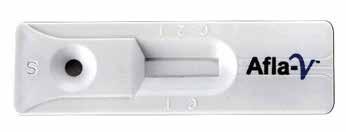
• Improves palatability
• Supports a healthy immune response
Protein Shortage
With the lack of available proteins, plasma can help when blended with more available, less functional co-products to provide the properties and characteristics of the original protein or replace less desirable ingredients.
Plasma can replace egg products in formulas
MYCOTOXIN TESTING SOLUTIONS
Afla-V Methanol
Afla-V strip tests accurately detect and measure total aflatoxins B1, B2, G1, and G2 at levels as low as 2 ppb and as high as 100 ppb. The single dilution sample preparation procedure saves time and materials, and the test takes 5 minutes* to develop
https://www.vicam.com/toxins/aflatoxin-b1-b2-g1-g2
Research shows that plasma provides equal or superior results to egg products in pet food formulas at a cost benefit. Benefits include improved:

• Protein
• Texture
• Cohesiveness
• Chewiness
• Palatability
https://apcproteins.com/applications/companion
32
STATE-OF-THE-ART TECHNOLOGY
CRISTAL: SOLUTIONS IN FLEXIBLE PACKAGING



Cristal Embalajes has a range of conventional flexible packaging solutions, multiple materials and 100% recyclable monomaterials with High Fat Barrier, OTR & WVTR with excellent mechanical properties, reconciling different models and application of accessories.
CYPZ SERIES - VACUUM COATER
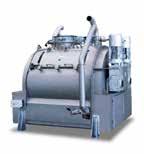

A high proportion of liquid (mainly oils, flavors, vitamins and probiotics) and powdered flavors can be added to the kibbles and improve the palatability of the product, increase the nutritional value, and enhance the competitiveness of the product in the market.
Performance Characteristics
• Pluggable type liquid nozzles, fast disassembly, and maintenance

• Heat jacket body, avoid condensate water




• Double sides and big-sized checking window, easy all-round cleaning and ensuring sanitary safety
• Batch coating, a more accurate measurement than continuous coating
• Unique rotor and blade design to reduce the breaking rate
• Full- length discharge door, fast material discharge, improve production efficiency
• Food grade bearing seal, excellent leak-proof http://en.famsungroup.com/products/detail?id=197
The multiple material structures can be combined with each other to better meet the needs of the products. They can be single layer, coextruded and laminated structures with the combination of different types of films and printing up to 10 colors:
• PE (white/transparent);
• PE (matte/glossy);
• PET (matte/metallic/glossy);
• PP (transparent/white);
• BOPP (matt/metallic/glossy/white);
• Aluminum;
• Poly Nylon;
For more information about our products:

Comercial Export
Email: vendas@cristalembalagens.com.br
Tel.: +55 48 3434 8000


Cristal Industria e Comercio de Embalagens
Plásticas Ltda.
Caixa Postal: 433 – CEP. 88830-00
Rodovia SC-443 - Km 16
Morro da Fumaça – Santa Catarina – Brasil
https://www.cristalembalagens.com.br/spa
33
cristalembalagens 100% Sostenible Gas Extraction Valve Holes shower type Flat bottom Edges rounded inn-lok zipper 360° zipper Zipper Pour & Lok cristalembalagens cristalemb
Empresa Brasileña
STATEC BINDER GMBH: HIGHPERFORMANCE PRODUCTS FOR HIGHSTANDARD CUSTOMERS
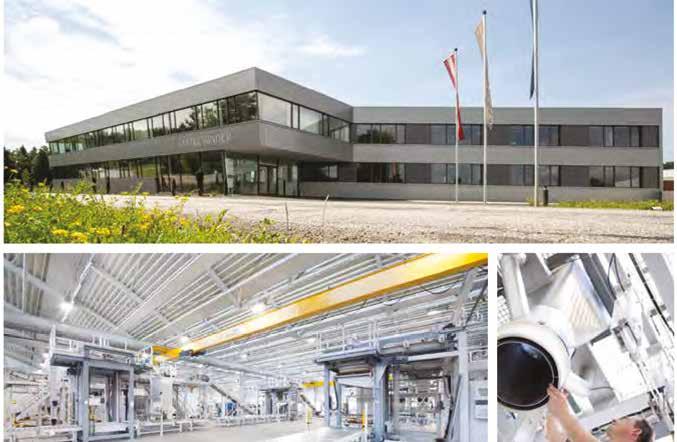 By STATEC BINDER
By STATEC BINDER
STATEC BINDER continuously manages to successfully apply its expertise as a bagging and palletizing specialist of bulk materials on a global scale. With its flexible and customer-oriented packaging technology, the Austrian company is represented on the international market, placing itself among the leading suppliers of high-performance open-mouth bagging machines. The wide-ranging product portfolio offers customized solutions of the highest quality for products used in a variety of industries.
The PRINCIPAC, CERTOPAC, ACROPAC, and CIRCUPAC open-mouth bagging systems are designed for polyethylene (PE), woven polypropylene (PP), and paper bags with a filling weight of 5 kg to 50 kg. The high-performance segment is complemented by the SYSTEM-T FFS (Form-Fill-Seal) machine for bag processing from tubular film and the SYSTEM-F vertical FFS machine for bag processing from the flat film.
The broad product range of STATEC BINDER is rounded off by robotic, high-level, and portal palletizing systems. The PRINCIPAL-H, PRINCIPAL-R, and PRINCIPAL-P palletizers are characterized by their high efficiency and adaptability. High-performance net weighers and bag closing systems ensure precise weighing and dosing, as well as a secure closure of bags.
Meeting customer needs globally
Starting from the food sector to the petrochemical industry –with over 1,700 machines installed worldwide, STATEC BINDER looks back on numerous positive references. The company counts small firms as well as large corporations, represented on all five continents, among its existing customer base.
Thanks to proven technology as well as continuous developments and optimizations, STATEC BINDER serves as an internationally recognized partner to many. After 40 years of experience, the company stands for absolute reliability, characterized by precision and constant innovation.
Customer service as a success factor
Customers all over the world put their trust in STATEC BINDER every day. Expert consulting services, a high level of service competence, and support for any concern provide reasons for this. Customer service is characterized by highly trained employees and online service with real-time support. The fullest satisfaction of the customers has the highest priority.
STATEC BINDER stands for…
• High-performance bagging and palletizing of bulk goods
• Machines and systems of the highest quality
• Flexible and customer-oriented solutions
• Absolute reliability, innovation, and precision
• Global customer service
• More than 40 years of experience
• Over 1,700 machines installed worldwide
Further information can be found on our website at www.statec-binder.com/en
34


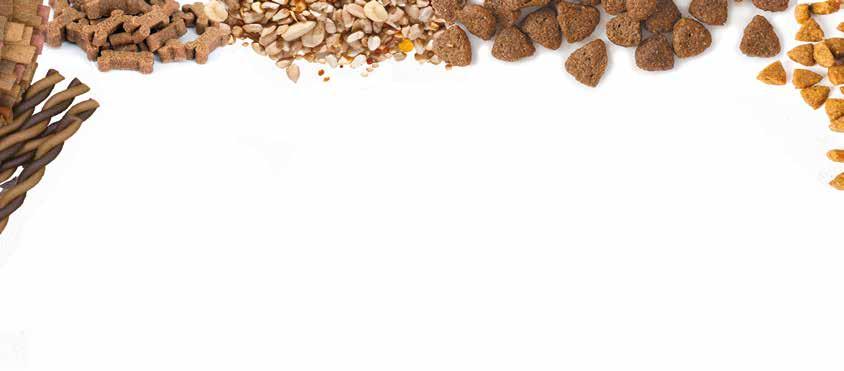
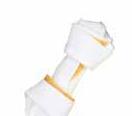







sales@cpmroskamp.com CPM.net CPM Argentina Junin 191 Piso 6 Of. 2 / Rosario (2000) | Santa Fe, Argentina / Ph: Ph: +54 911-5389-5312 CPM Brasil Av Ibirapuera, 2120 | Moema / São Paulo - SP | 04515-001 / Ph: +55-11-3074-4099 CPM Americas 2975 Airline Cir., Waterloo, IA 50703 - USA, Ph: +1-319-232-8444
FERRAZ: FROM BRAZIL TO THE WORLD
By FERRAZ
Ferraz is a Brazilian family business that started its activities in 1970. At that time, it mainly operated in the cereal market, such as rice processing. Then, it began manufacturing small flour feed mills for pig and poultry farms.

Over the years, we have greatly expanded our products and services portfolio until reaching the current stage, in which we supply complete plants for the production of 400 kg extruded meal feed at 16 tons per hour, 400kg pelletized at 30 tons per hour, and plants for mineral salt and premix production.
Nowadays, we are leaders in the market for machinery for extruded food production in Latin America.
In addition to the equipment, we also supply spare parts, through the division called “Ferraz Parts”, such as dies and roller covers for all the main pellet brands of the market. Our arrays, made of stainless steel material with perforation technology using gun drills and a vacuum quenching process, are what ensure an excellent roughness profile for the holes.
In addition, we also provide services such as Munck leasing, freight through our own fleet, and installation of compressed air, steam, liquids, and electrical networks.
We also have the “Autofer” division, our subsidiary dedicated to electricity and automation, which has a large and qualified team for the supply of power and control panels, CCM, and industrial automation software.
One of the great company’s competitive advantages is its capability to supply from the receiving hopper to the bagging machine, that is, all the necessary equipment for the feed production process.
In addition, we have the premise of dedicating special attention to after-sales, for which we maintain a high stock of spare parts for immediate delivery, and we also have a team of qualified technicians and specialists in each process, who are always visiting our clients and checking if needs some support, such as maintenance services (preventive and corrective) or training for its operators.
We monitor and support clients from the project-design phase, equipment manufacturing, delivery, start-up, and training of contracted operators.
36
Currently, we sell our products and services to 21 countries, with Latin America and the African continent as our principal markets.



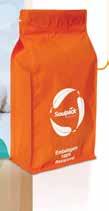

We consider it of great importance that the company always maintain its original values, which are respect and focus on customer satisfaction, the continuous search for innovation, and the humility to learn and share knowledge with all the people we are in contact with.
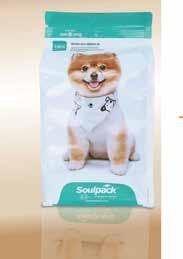
Significant investments are also made in our team’s qualification, either through courses and training given in the company itself or through cost allocations for undergraduate and specialization courses.

We always seek to offer the best cost/benefit ratio for our customers, which is why we attach great importance to maintaining short delivery times, as well as competitive prices and strict quality standards. The delivery time for complete factories, for example, is currently 4 to 6 months, depending on the size and complexity of the project.
One of the most outstanding pieces of equipment in our current portfolio are the twin-screw extruder and the model for the production of 10 to 12 tons/hour, E-150D, which was recently launched on the market. We have already observed great interest and demand for this equipment, mainly due to its high flexibility and productivity.

37
GRINDING: A FUNDAMENTAL POINT IN THE MANUFACTURE OF EXTRUDED DRY FOOD FOR CATS AND DOGS
 By Luana Pucca, Ludmila Barbi and Erika Stasieniuk
By Luana Pucca, Ludmila Barbi and Erika Stasieniuk
Ingredients, formulation, and processing are extremely important for quality pet food, and its value is recognized by both dogs and cats as well as their guardians. We highlight grinding as a fundamental point with a great impact on the efficiency and quality of all subsequent food processing stages, such as extrusion, drying, application of liquids, palatability, digestibility, and feces quality.
The grinding process consists of reducing and standardizing the particle size of raw materials, increasing the contact surface, and consequently improving steam and water absorption during the extrusion process, favoring dough cooking. All these aspects affect the texture and uniformity, avoiding partially cooked hard particles in the product.
Granulometry is influenced by the configuration of the mill and the parts that compose it. Before entering the mill, the presence of sieves and magnets will prevent foreign materials from reaching equipment, damaging parts, and impairing grinding quality. At the mill exit, to ensure the grinding quality, it is necessary to monitor the granulometry, which can be affected by perforated sieves or worn hammers, which will contribute to lower grinding efficiency and quality.
Better steam and water absorption in extrusion, as a result of quality grinding, improves the efficiency of starch gelatinization, the process of transforming granular starch into a viscoelastic paste.
Quality grinding and cooking allow better kibble expansion, formation, and structure. In general, product expansion is direct-
ly related to texture, being the products with the highest expansion, the most crunchy ones.
Some of the parameters used to assess the degree of cooking of dietary ingredients that are subjected to extrusion are density and water absorption rate. Foods with high density and low water absorption are signs of poorly expanded products, with inadequate starch gelatinization and less nutrient utilization (Camire, 2000).
The density of the expanded products is an important characteristic because, even indirectly, in addition to the expansion index, it indicates the degree of transformation of the starch granule.
In the drying process, heat transfer is responsible for liquid evaporation, present in the food, and mass transfer by water movement from the food interior to its surface, and from there to the environment. Therefore, drying is linked to both environmental and intrinsic conditions of the material being dried, which influence evaporation and water molecules diffusion rates, respectively.
38
Therefore, a kibble with good expansion and a uniform structure allows air to pass through it evenly, drying it properly, unlike a product that was compacted because it did not have an adequate process.

Even the kibble expansion and structure, also interfere with the process of applying the liquid. The croquettes must have the capacity to absorb fat since their efficiency depends on the size and porosity of the extrudate. A well-extruded product with a good structure provides better penetration and retention of the liquid coating.
Cereals (rice, corn, and wheat) are the most widely used starch sources in extruded dry food for dogs and cats. Some studies have shown that, if correctly extruded, cereal starch has an apparent digestibility greater than 95% for cats (DE OLIVEIRA et al., 2008) and 98% for dogs (CARCIOFI et al., 2008).
However, starch digestibility can be affected by factors such as starch composition and physical form, protein-starch interactions, cell integrity, and the physical form of the feed.
BAZZOLI (2007) evaluated the influence of milling of rice, corn, and sorghum on the apparent digestibility coefficient (ADC) of nutrients and fecal score in diets for dogs and found that there was a difference and interaction between carbohydrate sources in different millings. Mean starch and non-extractive nitrogen (ENN) ADCs were similar for the maize and sorghum diets, and higher for the rice-based diet. For maize and sorghum, coarse grinding had a negative effect, with values lower than those of diets prepared with fine and medium grinding.
Still according to BAZZOLLI (2007), regarding the fecal score, there was no ingredient effect either, only grinding. The evaluation of the contrasts shows that the higher the granulometry, the worse the fecal score for the three starch sources, and the worst score, being obtained with milled rice in a coarse granulometry.
The evidence shows that the higher the granulometry, the worse the fecal score of the diets, a fact that is probably due to the decrease in the starch gelatinization index, which results in less dry matter in the feces and a worse score. In cats, KIENZLE (1993) found that the ADC of starch in a diet containing coarsely ground raw corn was 72%. When the corn was cooked or finely ground, the ADC of the starch was 100%.
Starch digestibility alters and largely determines the postprandial blood glucose wave and the insulin response of the animal. In this way, the faster and more complete the digestion, the faster and more intense the triggered curve. This is an aspect that must be taken care of when thinking about food for animals with diabetes mellitus, obesity, pregnancy, cancer, and advanced age, which need greater control of the glycemic curve.
Therefore, we conclude that grinding is a key point in high-quality product development. It must be standardized, according to the reality of each factory, in addition to taking into account product purpose and life stage or state of health of the pet that will consume the food.
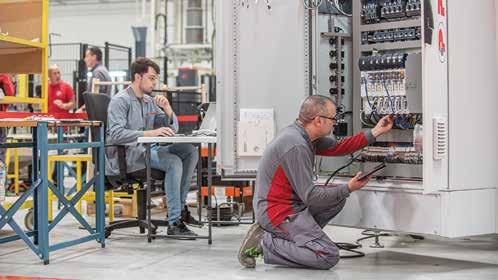


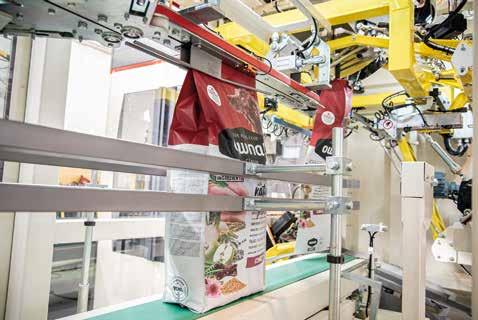

MARCELO BERALDO DA COSTA
Latam Director at AFB International
By All Pet food
Technology and innovation in AFB International
For this All Pet Food Magazine issue, we talked with Marcelo Beraldo Da Costa, LATAM Director of AFB International, about the challenges, growth, innovations and solutions the company will be working on this year.

Tell us a little about your professional career.
Before joining AFB, my most outstanding experience, I worked as a sales executive focused on ingredient and additives commercialization for animal and human nutrition at Danisco.
My journey at AFB started in 2005 as a Sales Executive in Brazil. At that time, we were still starting the company’s expansion in Latin America. I worked focusing on the development of
all areas necessary for the construction and operation of the facilities in Jaguaríuna - SP. In 2009, I was promoted to Brazil Director. In 2019, in the same position, I assumed responsibility for the operation in Mexico. Now, in 2022, I am very grateful to have been promoted to LATAM Director.
I graduated from the State University of Campinas (UNICAMP) with a degree in Food Engineering and a Master’s Degree in Business Administration and Marketing from ESPM.
40 THE INTERVIEW
Can you give us a small presentation of the company and its mission in the market?
AFB International was founded in 1986 in St. Louis, Missouri, USA. It is a subsidiary of Ensign-Bickford Industries, a private company for over 185 years focused on space and defense, pet food science, and biotechnology.
Our vision from the beginning was to create the best flavor palatants and make pet food taste amazing. Since then, AFB has partnered with pet food manufacturers to make dog and cat food, treats, and supplements with great flavors. This way, we ensure that pets receive the vital nutrition they need. We further enhance this partnership through research expertise, technical support, and outstanding customer service.
What are your main challenges as the new director of the company? What is your focus for 2023? What do you think is essential to focus your efforts on?
Now, as LATAM Director, my team and I are challenged to drive sales growth in the region, increase profitability and develop product requirements that meet the ever-changing needs of our emerging market.
What is the importance of working on the palatability of pet food products?
Even very nutritious food is worthless if a cat or dog doesn’t eat it.
That’s where the right palatability agent can make a difference. Palatabilizers are made with ingredients specially developed to improve food intake. They are created to stimulate one or more of a pet’s sensory capacities – olfactory, kinesthetic, taste, and texture.
What role do flavorings play in achieving good palatability?
Palatabilizers are essential to achieve good palatability, but it is far from being the only influencing factor. There are crucial factors for good food performance: product formulation, quality of ingredients, production process, etc.
These factors, together with the right palatability agent for the pet food company’s needs, are what will bring performance. That is why it is so important to consult the entire process that AFB provides to its clients because we think of palatability with a holistic view.
What flavoring technologies/proposals are currently growing?
We noticed great growth in new powder products with very high performance for cats. On the flip side, we’ve also seen a growing need for cost-effective palatability as manufacturers grapple with last year’s cost increases while, at the same time, receiving pressure from their customers about the economy and inflation. So it’s a contradiction in needs right now.
In relation to the trends in the industry, such as the high pet humanization or changes in
food, what changes have you made in your production process, technologies, or products?
Today, there is more focus on health and wellness. There is a desire to see more natural ingredients. That’s a lot like human eating tendencies, and that’s no coincidence. Human tendencies often end up migrating to pet food a little later.
For AFB, we see it as a responsibility to ensure that pets enjoy the taste of their meals, while also respecting the trends that our customers want to claim in their diets. Vegetarian dog food requires a vegetarian flavoring agent. A greater interest in wet cat food calls for palatabilizers that work well in this format. The inclusion of a nutritional ingredient may require extra palatability to mask its taste. Therefore, in this scenario of humanization, our innovation must focus on two things at the same time: meeting our customers’ palatability needs and their brand philosophy. As the pet food market grows and changes, AFB must constantly innovate to meet the needs of pet food companies.
What policies has AFB adopted in terms of the circular economy and sustainability?
AFB is committed to sustainable development. We always aim for a balance between protecting the environment and economic growth.
We ensure the sustainability of our projects, developments, and products throughout their life cycle, considering economic, environmental, and social impacts.
In addition, we train our workers on issues related to the correct disposal of all waste generated in the manufacturing process, also covering suppliers, competent bodies, and representative entities. The treatment of this waste is essential, and we correctly send it to treatment stations by environmental legislation.
AFB also achieved a “Silver” rating with ECOVADIS, a third-party sustainability auditor. This high score reflects the quality of our company’s sustainability management.
We also completed the self-assessment via SDG Action Manager against the Ten Principles of the United Nations Global Compact and the Sustainable Development Goals (SDGs). The SDGs work as a guideline to improve people’s and the planet’s conditions by 2030. AFB is committed to achieving this.
Another important action is being a member of the Pet Sustainability Coalition for two years, a global not-for-profit organization working to help the pet food industry towards a more sustainable future.
What do you consider to be the main current challenges for industry growth?
Despite the growth, the pet food market has also been challenging over the past two years. The entire pet food industry has focused on securing supply. The challenges arising from global supply chain issues and material shortages make our industry stronger and improve our resilience, but I believe they also caused pet food innovation to temporarily stall. Fortunately, our industry is coming out of it now, and stronger than ever to continue the transformation of this landscape.
41



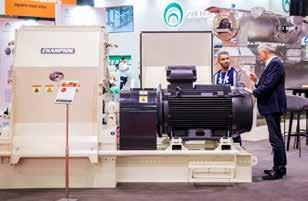








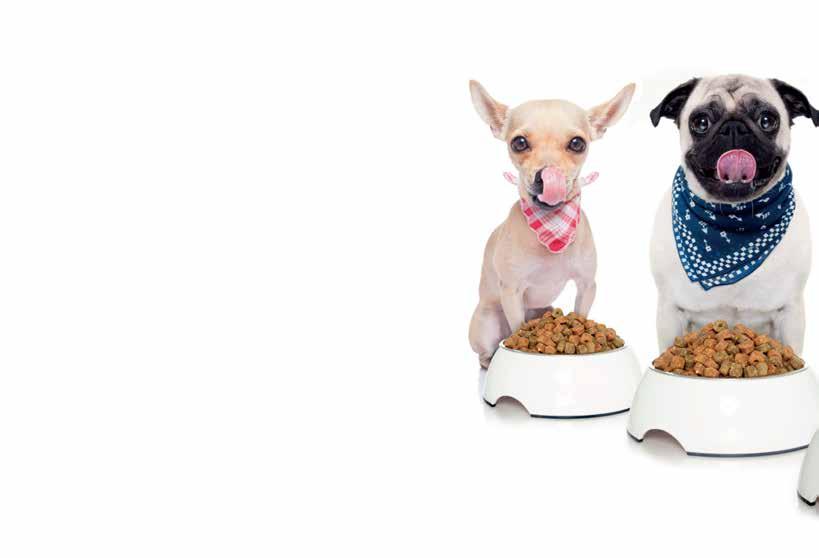
WHAT IS THE TECHNOLOGY INSIDE PET FOOD?
 By MVZ. Armando Enríquez de la Fuente Blanquet
By MVZ. Armando Enríquez de la Fuente Blanquet
The word technology comes from the Greek terms tekne (technical, craft) and logos (science, knowledge). A good way to distinguish technology from science and art is through its purpose:
- Science seeks the truth through scientific methods.
- Art seeks to reach human feelings, intellectual pleasure, and the beauty of all things.
- Technology seeks to satisfy human needs and desires, to solve practical problems using, in part, science.
Technology can be more broadly defined as entities, both material and immaterial, created by a mental and physical effort to achieve some value. In this usage, technology refers to tools and machines that can be used to solve real-world problems. It’s a broad term that can include simple tools, like a crowbar or wooden spoon, or more complex machines, like a space station or a particle accelerator. Tools and machines do not need to be material; virtual technology (such as computer programs and business methods) is also included in this definition of technology.
Pet food is the combination of a large number of technologies. If we start from the first contact with a product we buy in the market for our pet, that’s the packaging. The packaging today is resistant, transportable, and allows food to be kept in the best conditions so that it preserves the quality and balance of all its nutrients throughout its lifetime. Once we open the packaging (if we are talking about a dry product), we can find croquettes of different shapes, colors, and figures, which are highly digestible for our dog or cat. These croquettes were achieved by an extrusion process, and have high palatability, largely because inside them, there are the ingredients selected to meet quality and safety standards that guarantee the nutrient content. If we go deeper and deeper into that kibble, we see that it contains micronutrients, and they are present in the amount that the dog or cat needs at ppm or mg/kg levels, and sometimes up to ppb or mcg/kg.
One of these micronutrients is vitamins. Today, all vitamins are commercially produced in pure forms. Most are produced by chemical synthesis, but some are also isolated from natural sources (like fat-soluble vitamins), while others are produced microbiologically (such as thiamine, riboflavin, folate, pyridoxine, biotin, pantothenic acid, and vitamin B12). In some cases, synthetic vitamins can be significantly more bioavailable than vitamins from natural sources. The chemical stability of some vitamins can be improved by using a more stable chemical form or formulation. For instance, the calcium salt of pantothenic acid is more stable than the free acid form. Similarly, the esters of
vitamins A and E (retinyl acetate, tocopheryl acetate) are much more resistant to oxidation than alcohol-free forms. Vitamin preparations can also be coated or encapsulated in a way that excludes oxygen and/or moisture (fig.1), making them more stable. They are often spray-dried or prepared as adsorbates to improve their handling characteristics.
Traducción imagen: matriz: matrix - recubierta: coveringsustancia activa: active substance
Once again, technology makes it possible to guarantee the vitamin levels the pet requires in the balanced food eaten every day. However, within the kibble, a series of chemical events can occur that will compromise the life of these vitamins. The presence of trace minerals such as zinc, copper, iron, manganese, iodine, and selenium, in their free state, interact with other nutrients, degrading them or affecting digestibility. These free metals bind to other nutrients, making them unavailable. Generally, the raw materials of the balanced feed provide trace minerals, and it would be enough to prevent deficiencies, but presents variable bioavailability and does not meet the requirement, so it is necessary to supplement the diet with trace minerals that can be from inorganic, organic or hydroxymineral sources. Inorganic trace minerals (sulfates) have a weak ionic bond between the copper ligand and sulfate, as seen in Figure 2. The metal is easily exposed and, as mentioned above, will
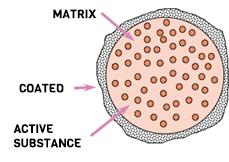
44
Fig.1 Vitamin A microencapsulated or microsphere.
affect other nutrients. No inorganic or organic trace mineral available today has the same chemical structure, mode of action, or bioavailability. Hydroxy minerals have an OH group that creates a strong, covalent bond with the metal. Covalent bonds have many proven advantages, including bioefficacy and feed stability.

Guaranteeing the nutritional levels of each nutrient requires selecting high-quality ingredients and, in particular, speaking of vitamins and minerals, stable sources. In addition, it is necessary to ensure that the nutrient is present, despite the loss that may occur when going through the thermal process or its interactions with the metals in the diet. I’ll take biotin as an example. Although there are variations depending on the reference, biotin doses of 0.6-1.2 mg/kg are recommended in Davenport’s work to keep the skin and coat of dogs in good condition. The amounts are very small on the order of ppb, so 2% or 10% commercial products are generally used, which can be in the form
of ground products or spray-dried products. A crushed product may contain around 2 million particles per gram of commercial product and a spray-dried product up to 40 million particles per gram of commercial one. Therefore, a product with a larger number of particles improves dispersion.
There is one area that I would not want to overlook, and that is that pet food is becoming more and more sustainable. A good example is the use of new sources of omegas, particularly DHA, from marine algae. These sources help reduce the exploitation of marine fishing and, in this way, help conserve ocean biodiversity.
As science and knowledge advance, pet food is the result of technological advances by being better every day, being more precise in meeting nutritional requirements, and supporting the health and well-being of our pets in a sustainable way.
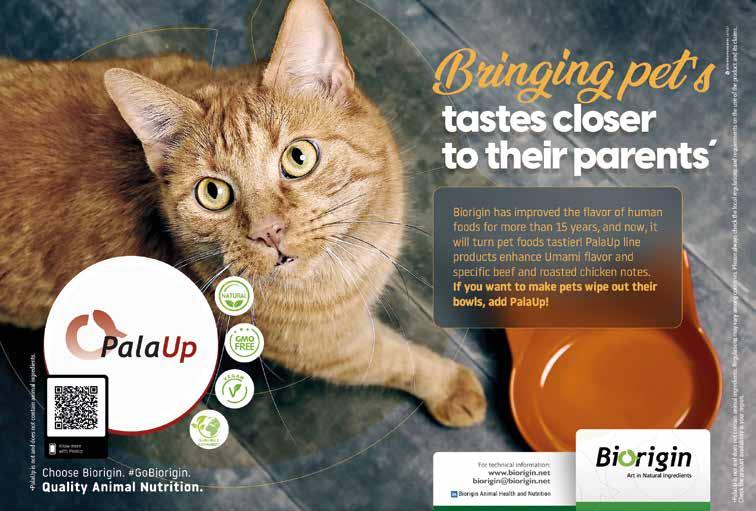 Fig.2 Chemical structure of different Cu sources (sulfate, proteinate, and hydroxy)
Fig.2 Chemical structure of different Cu sources (sulfate, proteinate, and hydroxy)





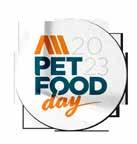




47 ONLINE Online Platform News Technical content Training Media files Interviews Market place
y courses Public & Private Trainings TRAINING Congress Meeting points Training Networking CIPAL - CIPEU - All Pet Food Day CONGRESS Stats Market Information and trends ANALYTICS MAGAZINE Quarterly Magazine
Webinars
Content of excellence Leading Guest Editors Digital and Printed 14 issues of the magazine
Pet food Media
the Pet
industry
innovation
the
info@allpetfood.net company/all-petfood https://allpetfood.net
We promote your marketing strategy with different options:
The
chosen by
Food
who provides
and value to
entire sector.

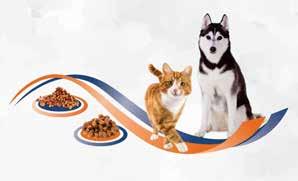




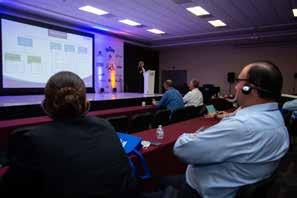

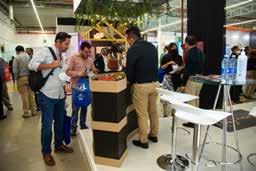
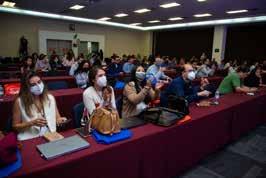




48

MARKETPLACE INDUSTRY SUPPLIERS

Nutrition/Palatabilizers
Symrise Pet Food +55 19 99266-3331 marcio.ponce@symrise.com www.symrise.com

AFB INTERNATIONAL +54 11 4 894 8570 argentina@a international.com https://a international.com/
Callizo Aromas +57 (305) 814 9448 info@callizoaromas.com www.callizoaromas.com
Nutrition / Immunity
Yeruvá
+54 (0)3496 425474 /475 /476 federicoguida@yeruva.com.ar www.yeruva.com.ar
APC

+55 11 93472-2145 marcos.razze@apcproteins.com https://apcproteins.com/
Biorigin +55 (14) 3269 9200 biorigin@biorigin.net www.biorigin.net
Nutrition / Additives
Brascorp +54 (3327) 411440 brascorp@brascorp.com.ar https://www.brascorp.com.ar/
Nutrition/ Gut health
Biorigin +55 (14) 3269 9200 biorigin@biorigin.net www.biorigin.net
Automation
NorthWind Technical Services LLC




+1 7 852 840 080 kastorga@northwindts.com www.northwindts.com
KSE +31 6 11820906 info@kse.nl https://www.ksegroup.com/es
Processing/Machinery
Buhler Group + 52 722 262 05 12 info@buhlergroup.com https://www.buhlergroup.com/

Processing/Machinery
Extru-Tech
+1 (785) 284 2153 extru-techinc@extru-techinc.com www.extru-techinc.com
Famsun Group +86 (514) 878 48880 mypublic@famsungroup.com www.famsungroup.com
Ferraz +55 (16) 3934 1055 vendas@ferrazmaquinas.com.br www.ferrazmaquinas.com.br
Gea Group +569 3402 3810 info@gea.com www.gea.com
Maverick +55 16 99615 22 33 cmathias@maverickedg.com http://www.maverickedg.com/

Wenger Manufacturing, Inc +1 (785) 284 2133 info@wenger.com https://wenger.com/
Schenck Process
+1 (816) 891 9300 americas@schenckprocess.com https://www.schenckprocess.com/
Industrias Bartoli Hnos +54 (0343) 486 2707 info@bartolihnos.com.ar www.bartolihnos.com.ar
Andritz Group +43 (316) 6902 0 welcome@andritz.com www.andritz.com
Conveyors
Clablevey Conveyor
Mills Pesaje y dosificación
CPM +54 (9) 11 5389 5312 sales@cpmroskamp.com www.cpm.net
PLP Systems +39 (0523) 891629 info@plp-systems.com www.plp-systems.com

KSE +31 6 11820906 info@kse.nl https://www.ksegroup.com/es
Packaging
Soulpack +55 (48) 3052 8700 comercial7@soulpack.com.br https://soulpack.com.br/
Packaging Equipment
Statec Binder +43 (3112) 38580 0 o ce@statec-binder.com www.statec-binder.com
Payper +34 973216040 david.pernia@payper.com https://www.payper.com/

Consultancy
Clivio Solutions + 54 9 2352 540040 francisco.pantoni@cliviosolutions.com www.cliviosolutions.com
Market Consulting
Triple Three International +521 (552) 187 4357 ifranco@triplethreeinternational.com www.triplethreeinternational.com
M de ranspo
+1 (641) 673 7419 info@cablevey.com www.cablevey.com
BARTOLI HNOS S R L NDUST AS

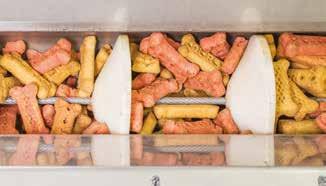

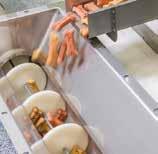
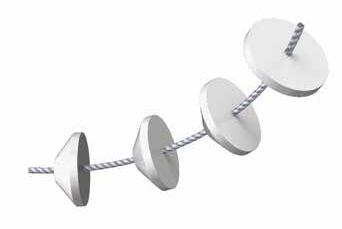



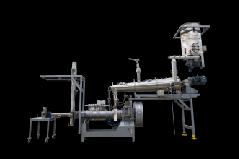


The Heart of the System CABLE & DISCS Dry Cleaning Brush Box Cablevey® Conveyors is a registered trademark of Intraco, Inc. 10/2022 • Leader in Tubular Drag Conveying • Gentle on your materials! • Starts & Stops Under Load • Dust-Free Enclosed System • Clean-in-Place Options • Low Maintenance • Energy-efficient System Capacity: • 8” (203.2mm) tube diameter • Moves up to 2,000 Ft³ (56.6 M³)/hr • Moves up to 80,000 lbs/hr (36,287 Kgs/hour) (depending on bulk density of materials) 8” Systems www.cablevey.com +1(641) 673-8451 info@cablevey.com Experts in Cable & Disc Conveying Solutions Gentle Clean Reliable Conveying Single Screw Extruder WENGER DO BRASIL ALAMEDA ITATUBA, 2232 JOAPIRANGA II 13278 - 520 VALINHOS - SP BRASIL TEL +55 3881 5060
























































52
September 27, 28
EUROPE PET FOOD INDUSTRY CONGRESS


www.cipeu.es
More than an event, a meeting point
Zaragoza Congress Palace
Zaragoza | Spain
53
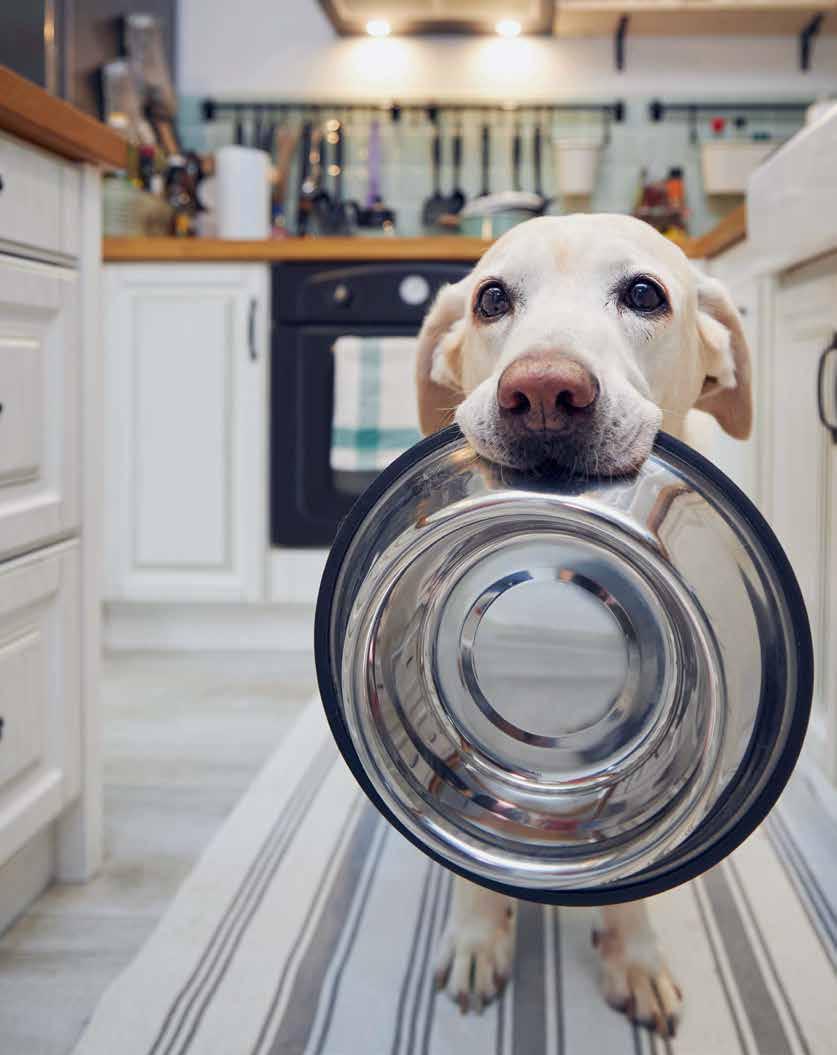



















 By All Pet Food
By All Pet Food


















 Kibbles
Pillows
Dental sticks
Kibbles
Pillows
Dental sticks
















 By All Pet Food
By All Pet Food
















 By STATEC BINDER
By STATEC BINDER


















 By Luana Pucca, Ludmila Barbi and Erika Stasieniuk
By Luana Pucca, Ludmila Barbi and Erika Stasieniuk















 By MVZ. Armando Enríquez de la Fuente Blanquet
By MVZ. Armando Enríquez de la Fuente Blanquet


 Fig.2 Chemical structure of different Cu sources (sulfate, proteinate, and hydroxy)
Fig.2 Chemical structure of different Cu sources (sulfate, proteinate, and hydroxy)































































































